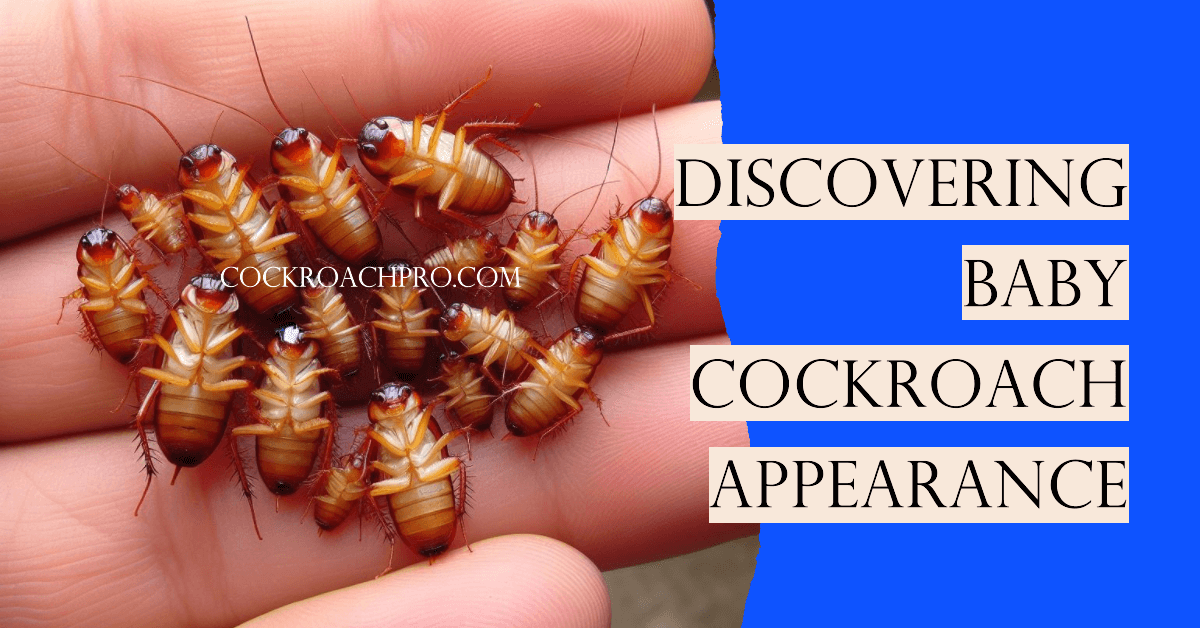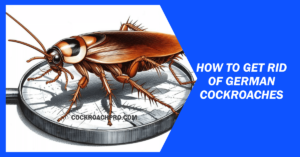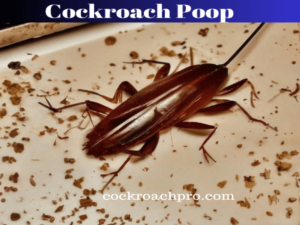Have you ever wondered what do baby cockroaches look like? Well, let me share my personal experience with you.
Cockroaches, those infamous household pests, have a life cycle that includes an often-overlooked stage: baby cockroaches, known as nymphs. Understanding what these baby roaches look like is crucial for effective pest management.
In this article, we’ll explore the intriguing world of baby cockroaches, breaking down their appearance, growth, and behavior. Let’s delve into the details with structured sections for your better understanding.
The Life Cycle of Cockroaches
Cockroaches undergo incomplete metamorphosis, a process that includes the egg stage, the nymph stage, and the adult stage. In this section, we’ll briefly explain the life cycle to provide context for understanding baby cockroaches.

What Do Baby Cockroaches Look Like?
1. Size Matters
Baby cockroaches are notably smaller than their adult counterparts, measuring just a few millimeters in length. Their tiny size gives them a remarkable ability to hide in the most minuscule cracks and crevices.
This smallness profoundly influences their behavior, allowing them to remain unseen by both potential predators and homeowners. This hidden presence complicates the identification and management of infestations, often making them more extensive than initially apparent.
Furthermore, their minute dimensions provide them with access to concealed food and water sources, making the task of eradicating them challenging once they establish a presence in your home. The small size of baby cockroaches is a vital survival strategy, enabling them to thrive discreetly and avoid detection effectively.
2. The Color Palette
The coloration of baby cockroaches is a variable feature that not only distinguishes different species but also evolves with age. Understanding this color transformation is vital when attempting to identify the species and age of a cockroach infestation.
Newly hatched nymphs often exhibit a pale, almost translucent appearance, with a coloration that can range from white to gray. However, as they progress through their growth stages, they undergo significant changes in color. This transformation is like a coming-of-age story in the cockroach world.
The exact hue that baby cockroaches eventually adopt depends on their species. For instance, American cockroach nymphs emerge with a distinct reddish-brown tint that gradually darkens as they mature into adults. In contrast, German cockroach nymphs begin with a lighter, tan-like color and darken with age.
3. Shapely Characters
Baby cockroaches share a similar body shape to adult roaches with their elongated, oval form. They have a distinctive small, rounded head, segmented body, and the standard six legs evenly spaced along their body.
One notable feature in baby cockroaches is the presence of underdeveloped wing pads. These wing pads won’t enable them to fly at this stage but are crucial indicators of their species and age, offering insights into their potential for future flight. Understanding these physical attributes can help in identifying these pests and tailoring effective pest control strategies.
4. Antennae Insights
Like their adult counterparts, baby cockroaches are equipped with long, slender antennae. In this section, we’ll delve into the functions of these sensory appendages, which play a significant role in their survival and interaction with the environment.
The antennae of baby cockroaches, just like those of adults, serve as essential tools for navigating their surroundings. These sensitive appendages are finely tuned to detect environmental cues, such as chemical signals, humidity levels, and the presence of potential food sources. This heightened sensitivity aids them in locating shelter, water, and sustenance.
5. Swift and Agile
Baby cockroaches display impressive agility and rapid movements, akin to their adult counterparts. Their ability to swiftly scurry away when disturbed is a key characteristic we’ll explore in this section. Understanding their behavior can be instrumental in spotting and effectively managing infestations.
The nimbleness and speed of baby cockroaches are adaptations that aid in their survival. When they sense a potential threat, such as a human presence or the flick of a light switch, their rapid reflexes kick in. These tiny roaches can disappear into cracks, crevices, and the tiniest of hiding spots in the blink of an eye, making them elusive targets for capture or detection.
This behavior poses a challenge when trying to identify an infestation, as it allows baby cockroaches to escape notice and perpetuates their presence in a home. By understanding their capacity for quick evasion, homeowners and pest control professionals can better devise strategies to address the infestation effectively.
In summary, the swift and agile nature of baby cockroaches is a critical element of their survival strategy. Recognizing this behavior is key to both identifying and successfully managing cockroach infestations, as it enables you to anticipate their evasive tactics and tailor your pest control efforts accordingly.

Do baby cockroaches move quickly?
Yes, baby cockroaches do move quickly. Much like their adult counterparts, they exhibit remarkable agility and rapid movements. When disturbed or sensing potential threats, they can scurry away swiftly, disappearing into cracks and crevices with impressive speed. This agility is a key survival mechanism that allows them to evade predators and effectively navigate their environment.
What can be mistaken for a baby roach?
Several small insects and arthropods can be mistaken for baby cockroaches due to their size and appearance. Some common creatures that might be confused with baby roaches include:
Carpet Beetles: Carpet beetle larvae are tiny, brownish creatures that can be mistaken for baby roaches. They have a similar size and shape.
Booklice: Booklice are extremely small insects that are often found in humid environments. They have a similar size but appear more translucent and lack the distinct cockroach body shape.
Silverfish: Silverfish are slender, wingless insects that share some similarities in size and color with baby cockroaches. However, they have distinct, elongated bodies.
Crickets: Young crickets can sometimes resemble baby cockroaches due to their size and color, but they have longer hind legs and a different body shape.
Small Beetles: Various small beetle species might be confused with baby roaches, especially if they have a similar size and coloration.
It’s important to carefully observe the characteristics mentioned earlier, such as body shape, antennae, and the presence of wing pads, to differentiate baby cockroaches from these other insects.
Why am I seeing baby roaches in my bedroom?
The presence of baby cockroaches in your bedroom can be concerning, as it may indicate an underlying cockroach infestation in your home. There are several reasons why you might be seeing baby roaches in your bedroom:
1. Food and Water Sources
Cockroaches, both adults and nymphs, are attracted to environments with accessible food and water sources. In your bedroom, this can include crumbs, food spills, or even pet food. Baby cockroaches are particularly skilled at exploiting these food remnants.
They feed on organic matter and are known to scavenge for any available sustenance. If you often consume snacks in your bedroom or have a habit of leaving unfinished food or drink containers around, this can create an ideal environment for cockroaches to thrive.
To mitigate this, it’s crucial to maintain a clean and food-free bedroom. Store any food in airtight containers and make it a habit to clean up after yourself regularly.
2. Hiding Places
Cockroaches are nocturnal creatures, which means they are most active during the night and prefer to hide during the day. Bedrooms offer numerous hiding spots for these pests.
They often take refuge in dark, secluded spaces, such as cracks in walls, behind or under furniture, inside storage items, or even in the folds of curtains. The abundance of these potential hiding places in a typical bedroom provides an attractive sanctuary for cockroaches, including baby roaches.
To address this, consider decluttering and organizing your bedroom to eliminate potential hiding spots. Regularly inspect and clean the areas behind furniture and in the corners of your room.
3. Access Points
Cockroaches are skilled infiltrators and can enter your bedroom through small cracks or gaps in walls, floors, ceilings, or even through vents and pipes. They are known for their ability to squeeze through incredibly tight spaces.
To prevent their entry, it’s important to seal any potential entry points. Carefully inspect your bedroom for cracks, gaps, or openings and use caulk, weather stripping, or other appropriate sealants to block these access routes. Additionally, make sure windows and doors are properly sealed and that screens are intact to keep cockroaches out.
4. Infestation Elsewhere
While you’re seeing baby roaches in your bedroom, it’s essential to understand that the primary infestation might be located in another part of your home, such as the kitchen, bathroom, or basement.
Cockroaches often spread from one area to another in search of food, water, or suitable hiding places. If you’re facing an infestation, it’s essential to identify the source. Take note of where you’ve spotted the most cockroaches in your home.
This information can guide your pest control efforts. Treating the source of the infestation, rather than just addressing the symptoms in your bedroom, is essential for long-term control.
5. Warm and Humid Environment
Bedrooms tend to offer a warm and relatively humid environment, which can be attractive to cockroaches. This comfortable environment makes cockroaches more active and visible, particularly at night when they’re searching for food or water.
The warmth and humidity in your bedroom create favorable conditions for their reproduction and survival. To mitigate this attraction, consider using dehumidifiers in your bedroom to reduce moisture levels, making the environment less welcoming to cockroaches.
6. Prompt Action
If you’re seeing baby cockroaches in your bedroom, it’s crucial to take prompt action. The presence of nymphs is a clear indication of an infestation that requires attention. Ignoring the issue can lead to a more extensive problem.
Start with thorough sanitation to eliminate food sources, seal potential entry points, and declutter your bedroom to remove hiding spots. If the infestation persists or if you suspect the primary source is elsewhere in your home, it’s advisable to consult with a pest control professional.
They can accurately identify the source of the infestation and implement effective treatment strategies to eradicate the problem.
Conclusion
Recognizing their physical attributes and behavior is important for early detection and prompt action. Whether you’re dealing with a potential infestation or aiming to prevent one, this knowledge will be invaluable in safeguarding your home from these resilient intruders.
Effective cockroach control involves thorough sanitation, sealing entry points, and, if necessary, seeking professional pest management. By staying informed about the appearance and behavior of baby cockroaches, you can better protect your home and family from these unwelcome guests.




